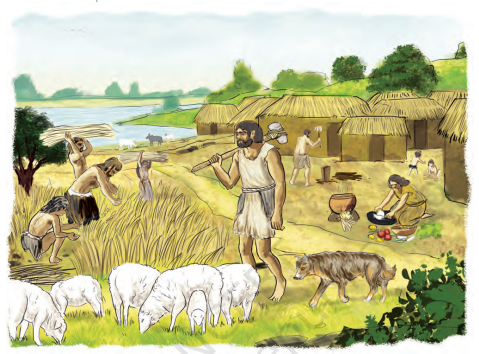Timeline and Sources of History Class 6 important questions with answers PDF download
FAQs on CBSE Important Questions for Class 6 Social Science Timeline and Sources of History - 2025-26
1. What are the important sources of history as discussed in CBSE Class 6 Chapter 4, and how does each source help in understanding the past?
- Archaeological sources: Include tools, pottery, bones, and ancient structures; help reveal daily life and technologies.
- Written records: Books, inscriptions, and manuscripts; provide direct information about events and cultures.
- Oral traditions: Stories and legends passed down; offer insights into social values and collective memory.
- Artistic sources: Paintings, sculptures; reflect beliefs and practices.
2. Explain the significance of timelines in Class 6 Social Science, and how do they prevent common exam mistakes related to historical sequencing?
Timelines visually arrange events in chronological order, making it easier to see what happened first and how one event leads to another. This prevents confusion in date sequencing—a frequent exam error—by helping students correctly order and relate events, as per CBSE exam trends for 2025–26.
3. Why do CBSE exams for history often include questions comparing the terms BCE/CE and BC/AD? Explain their differences for Class 6 scoring purposes.
BCE (Before Common Era) and CE (Common Era) are non-religious calendar terms; BC (Before Christ) and AD (Anno Domini) are traditional, religiously rooted terms. Understanding both is needed for CBSE scoring, as questions may require distinguishing between them or converting dates, a typical 2-mark conceptual trap.
4. How do fossils serve as important sources of history in Class 6, and what misconceptions must students avoid regarding their role?
Fossils are physical remains of ancient life forms and provide direct evidence about past species and environments. Common misconceptions: Fossils do not offer information about written history or human inventions, and must not be confused with artefacts. For exam clarity (HOTS), always separate fossil evidence from man-made objects.
5. What are the key differences between a decade, a century, and a millennium, and why is this important for Class 6 ‘marking weightage’ questions?
- Decade: 10 years
- Century: 100 years
- Millennium: 1,000 years
6. In CBSE Class 6 exams, why is it necessary to refer to multiple types of historical sources as per the 2025–26 pattern?
Using diverse sources (archaeological, written, oral, artistic) allows students to provide a balanced answer and avoid bias or incomplete information. CBSE increasingly prioritizes answers that synthesize evidence, a key factor in scoring 3-mark and HOTS questions for 2025–26.
7. What role do archaeologists, geologists, and palaeontologists play as important contributors to history in Class 6 Social Science?
- Archaeologists: Study man-made remains to uncover human activity.
- Geologists: Examine Earth's layers and materials, providing context on natural changes over time.
- Palaeontologists: Analyze fossils to understand pre-human and ancient life.
8. How does understanding the concept of 'no year zero' in the Gregorian calendar help avoid mistake-prone calculations on history timelines?
There is no year zero between 1 BCE and 1 CE, which means students must subtract one when calculating total years across BCE and CE. This technical point often appears in CBSE higher-order questions to test attention to detail and timeline accuracy.
9. Why are sources of history compared to pieces of a jigsaw puzzle in Class 6 important question papers (2025–26)?
Each historical source provides a partial view of the past. Only when different sources are combined and interpreted together can we form an accurate and complete picture—just like assembling a jigsaw puzzle. This comparison is commonly used in CBSE for 3-mark or HOTS questions to assess understanding of historical method.
10. What are the higher-order thinking skills (HOTS) needed for answering important questions on timelines and sources of history in the CBSE Class 6 exam?
Key HOTS include:
- Identifying relationships between events on a timeline
- Comparing diverse historical sources for reliability
- Drawing cause-and-effect conclusions from data
- Recognizing bias or gaps in historical information
11. How does the study of early human life using multiple sources impact present-day understanding and exam application for Class 6 students?
By analyzing artefacts, fossils, and oral traditions, students gain a fuller understanding of how human societies evolved and addressed challenges. For CBSE, making connections between early human innovations and their present-day implications demonstrates advanced application, often rewarded in 4- or 5-mark answers.
12. What is one common conceptual trap regarding the use of timelines in Class 6 history exams, and how can it be avoided?
Students often mistake the chronological order or misinterpret overlapping events. To avoid this, always read the timeline carefully, note the direction of dates (BCE to CE), and verify event placement against key dates—a tip highlighted in recent CBSE examiner reports.
13. In CBSE Class 6 important questions, how do historians act like detectives when using sources of history?
Historians analyze clues from diverse evidence (documents, artefacts, oral stories) to reconstruct what happened in the past, similar to detectives piecing together a case. This analogy helps in structuring ‘explain’-type answers for 3-mark CBSE questions as per 2025–26 trends.
14. Which key historical milestones are often covered in Class 6 Social Science Chapter 4 important questions for the CBSE 2025–26 exam cycle?
Milestones include: the invention of fire, development of early tools, beginning of settled agriculture, emergence of civilizations, and use of written language. Recognizing these helps with timeline and sequence-based MCQs and short-answer questions.
15. How should students approach a 5-mark CBSE question requiring analysis of multiple sources from a specific period in history for Class 6 important questions?
Students should:
- List types of sources relevant to that period
- Explain what each source reveals
- Cross-verify information for consistency
- Note limitations or strengths of each source
- Conclude with a summary of how these sources together provide a clearer picture

























